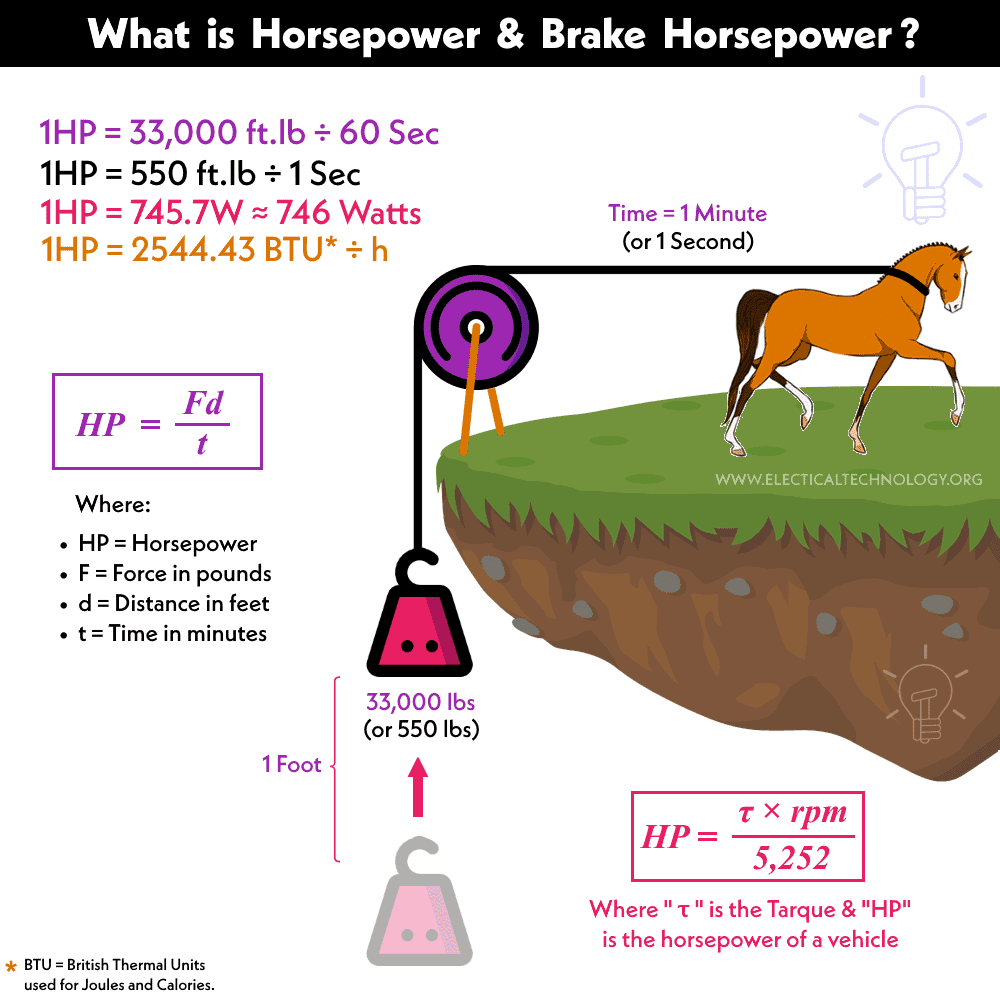Difference Between HP & BHP? Horsepower vs Brake Horsepower
Difference Between Horsepower and Brake Horsepower? HP vs BHP
Except for electrical machines such as motors, you may frequently hear the word horsepower (HP) if you are a car enthusiast, related to engines or general vehicles and mostly from the mechanics in the machine shops. But there is another unpopular term as BHP (Brake horsepower). Let’s know and differentiate what is HP and BHP as follows.
What is HP?
The HP (horse power) is the measuring unit of power in the foot-pound-second (F.P.S). HP is always measured in horsepower or watts.
Definition of Horsepower:
The rate of working of 33,000 ft.lb per minute or 550 ft.lb per second is known as 1 horse power.
In other words, the power necessary to lift a weight of 33,000 lb. at 1 ft in height for one minute, or lift a total mass of 550 pounds one foot in one second is called one horse power.
Mathematically
HP = Fd ÷ t
Where:
- HP = Horsepower
- F = Force in pounds
- d = Distance in feet
- t = Time in minutes
This way, 1HP = 33,000 ft.lb /60 sec = 550 ft.lb / sec = 550 x 1.356 Joules / sec = 746 Watts … (∴ 1 ft.lb = 1.356 Joules)
- 1HP = 33,000 ft.lb / 60 sec
- 1HP = 550 ft.lb / sec
- 1HP = 745.7 Watts ≈ 746 Watts ÷
- 1HP = 2544.43 BTU / h
Where 1 BTU = British Thermal Unit (used in Joules for Calories). Similarly
- 1 kW = 1000 Watts = 1.34 HP.
Related Posts:
What is BHP?
The output power from the motor is known as BHP (Break Horse Power). In other words, the pure mechanical output power from the motor shaft is known to be BHP. The brake horsepower (BHP) is always less than the motor’s input power.
Keep in mind that BHP is also measured in HP or Watts.
Difference between Horsepower and Brake Horsepower?
To differentiate the two different terms (HP and BHP), let’s see the following examples.
If we say a 5 HP motor, it means the motor needs 5 x 746 W = 3730 Watts electrical power to run and operate. The output of the motor will always be less than the 5HP (or 3730 Watts). This is because some losses occur in the machine windings (armature and stator, friction and windage etc.).
If we say a 5 BHP motor, it means the output mechanical power of the motor is equal to the 5 x 746 W = 3730 Watt electrical power. In this case, we don’t care about the losses in the motors. In short, it is the pure mechanical power (or torque (τ) where HP = τ × rpm/5252) to the output load connected to the shaft of the motor.
This way, the amount of BHP is always greater than the HP and vice versa. An HP is the rating of the motor (initial input power needed to run the machine) while BHP is the pure and actual mechanical output power without losses.
Keep in mind that the maximum power develops in the motor when EB = V/2 = IaRa.
Where:
- EB = Developed power in machine
- V = Supply voltage
- Ia = Armature current
- Ra = Armature resistance
In addition, the machine efficiency will be maximum when the copper losses are equal to the constant losses.
Related Posts:
- Difference Between Brushed and Brushless Motor
- Difference between Synchronous and Asynchronous Motor
How to Calculate Horsepower?
To calculate the horsepower of a motor, just simply divide the value of horsepower on 746. For example, to calculate the value of 3kW motor in horsepower is
3,000 Watts ÷ 746 = 4 Horsepower.
Similarly, to calculate the value of an engine in horsepower, divide the product of torque and speed in RPM on a constant value of 5,252. For example, the value of a vehicle engine in horsepower where the torque is 275 n-m and the rotation per minute is 3600, the value of the vehicle in horsepower would be
HP = ( τ × rpm ) ÷ 5,252
HP = ( 275 n-m × 3600 ) ÷ 5,252
HP = 188.5 Horsepower
If you want to convert the 188.5 horsepower of the above electric vehicle into kW, simply divide it to 0.746.
- kW = HP × (746 ÷ 1000)
- kW = 188.5 × (746 ÷ 1000)
- kW = 140.5 kW.
Related Posts:
- Difference Between Current and Voltage
- Difference between AC and DC (Current & Voltage)
- Difference Between EMF and MMF
- Difference Between Voltage and EMF?
- Difference Between Electric Current and Electric Charge
- Difference Between Electric and Magnetic Circuit
- Difference between Electric Field and Magnetic Field
- Difference between Electron Current and Conventional Current
- Difference Between a Transformer and an Induction Motor
- Difference Between Current Transformer & Potential Transformer
- Differences Between Electrostatic & Electromagnetic Terms
- Difference Between NPN and PNP Transistor
- Difference Between Grounding, Earthing and Bonding
- Difference Between Single Phase and Three Phase Power Supply
- Difference Between GFCI and AFCI
- Differences Between HVAC and HVDC – Power Transmission
- Difference Between Series and Parallel Circuit – Comparison
- Difference Between Alternator and Generator with Comparison
- Difference Between Overcurrent, Overload and Overvoltage
- Difference between Lightning Arrester and Surge Arrester







